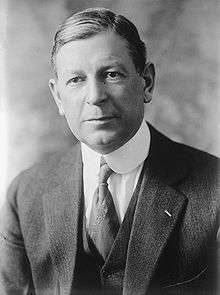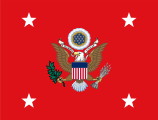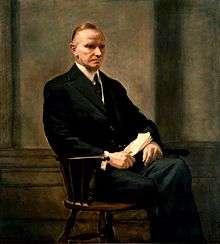Dwight F. Davis
Dwight Filley Davis, Sr. (July 5, 1879 – November 28, 1945) was an American tennis player and politician. He is best remembered as the founder of the Davis Cup international tennis competition. He was the Assistant Secretary of War from 1923 to 1925 and Secretary of War from 1925 to 1929.
Dwight F. Davis | |
|---|---|
 | |
| Governor-General of the Philippines | |
| In office July 8, 1929 – January 9, 1932 | |
| President | Herbert Hoover |
| Preceded by | Eugene Allen Gilmore (Acting) |
| Succeeded by | George C. Butte (Acting) |
| 49th United States Secretary of War | |
| In office October 14, 1925 – March 4, 1929 | |
| President | Calvin Coolidge |
| Preceded by | John W. Weeks |
| Succeeded by | James Good |
| United States Assistant Secretary of War | |
| In office 1923–1925 | |
| Appointed by | Calvin Coolidge |
| Preceded by | Mayhew Wainwright |
| Succeeded by | Hanford MacNider |
| Personal details | |
| Born | Dwight Filley Davis July 5, 1879 St. Louis, Missouri, U.S. |
| Died | November 28, 1945 (aged 66) Washington, D.C., U.S. |
| Political party | Republican |
| Education | Harvard University (BA) Washington University (LLB) |
Tennis career | |
| Turned pro | 1895 (amateur tour) |
| Retired | 1902 |
| Plays | Left-handed (one-handed backhand) |
| Singles | |
| Highest ranking | No. 5 (1900) |
| Grand Slam Singles results | |
| US Open | F (1898, 1899) |
| Other tournaments | |
| Olympic Games | 2R (1904) |
| Doubles | |
| Grand Slam Doubles results | |
| Wimbledon | F (1901) |
| US Open | W (1899, 1900, 1901) |
| Other doubles tournaments | |
| Olympic Games | QF (1904) |
| Team competitions | |
| Davis Cup | W (1900, 1902) |
Biography
Dwight Filley Davis was born in St. Louis, Missouri on July 5, 1879. His grandfather, Oliver Dwight Filley was mayor of St. Louis from 1858 to 1861.[1] A cousin, Chauncey Ives Filley served as mayor of St. Louis from 1863 to 1864.[2]
He reached the All-Comers final for the Men's Singles title at the US Championships in 1898 and 1899. He then teamed up with Holcombe Ward and won the Men's Doubles title at the championships for three years in a row from 1899 to 1901. Davis and Ward were also Men's Doubles runners-up at Wimbledon in 1901. Davis also won the American intercollegiate singles championship of 1899 as a student at Harvard College.
In 1900 Davis developed the structure for, and donated a silver bowl to go to the winner of, a new international tennis competition designed by him and three others known as the International Lawn Tennis Challenge, which was later renamed the Davis Cup in his honor. He was a member of the US team that won the first two competitions in 1900 and 1902, and was also the captain of the 1900 team.
He participated in the 1904 Summer Olympics. He was eliminated in the second round of the singles tournament. In the doubles tournament he and his partner Ralph McKittrick lost in the quarter-finals.[3]
Political service

Davis was educated at Washington University Law School, though he was never a practicing attorney. He was, however, politically active in his home town of St. Louis and served as the city's public parks commissioner from 1911 to 1915. During his tenure, he expanded athletic facilities and created the first municipal tennis courts in the United States. He served President Calvin Coolidge as Assistant Secretary of War (1923–25) and as Secretary of War (1925–29). He then served as Governor General of the Philippines (1929–32) under Herbert Hoover.
Army service
Davis trained at the Preparedness Movement Citizens' Military Training Camp in 1915. From 1916 to 1917 he toured Europe as part of the Rockefeller War Relief Board. With war declared Davis enlisted as a private in the Missouri National Guard and was commissioned in August 1917.[4]
Going to France, Davis was promoted to Major and became adjutant of the 69th Infantry Brigade of the 35th Infantry Division. During this period he was awarded the Distinguished Service Cross.[5] After the war he was a Colonel in the Army Reserves.
In 1942 Davis was the first and only Director General of the short lived Army Specialist Corps.[6] On the disbandment of the unit became an advisor with the rank of Major General.[7]
Personal life
His first wife, Helen Brooks, whom he married in 1905, died in 1932.[8] He married Pauline Sabin in 1936. He wintered in Florida from 1933 until his death, living at Meridian Plantation, near Tallahassee.[9]
Death
Davis died at his home in Washington, D.C. on November 28, 1945, after a six-month illness.[8][10]
Legacy
His daughter Alice Brooks Davis was married to the British Ambassador to the United States Sir Roger Makins. Another daughter, Cynthia Davis, was married to banker William McChesney Martin, Jr, the longest-serving Federal Reserve director (1951–1970) who served under five presidents (Truman to Nixon).
Davis was honored with a star on the St. Louis Walk of Fame.[11]
References
- "Dwight Filley Davis Family Tree".
- "Chauncey Ives Filley biography".
- "Dwight F. Davis Olympic Results". sports-reference.com. Archived from the original on 2014-02-01. Retrieved 2014-01-27.
- p. 94 Sobel, Robert Biographical Directory of the United States Executive Branch, 1774-1989 Greenwood Publishing Group, 1990
- http://www.arlingtoncemetery.net/dfdavis.htm
- p. 96 Specialist Corps Formed Popular Science October 1942
- p. 94 Sobel, Robert Biographical Directory of the United States Executive Branch, 1774-1989 Greenwood Publishing Group, 1990
- Political Graveyard Genealogies
- "Davis Cup has local tie". Tallahassee Democrat, 6 December 2007: 3C
- "Dwight Davis Dies. War Ex-Secretary. Member of Coolidge's Cabinet. First Soldier to Hold Post Since '69. New Deal Foe. Donor Of The Tennis Cup. Former Champion Himself, He Created International Trophy. Hero of First World War. Succeeded John W. Weeks. Twice Double Champion. Sold Progress in Philippines". The New York Times. Associated Press.
- St. Louis Walk of Fame. "St. Louis Walk of Fame Inductees". stlouiswalkoffame.org. Archived from the original on 2 February 2013. Retrieved 25 April 2013.
External links

- Dwight F. Davis at the Davis Cup

- Dwight F. Davis at the International Tennis Hall of Fame

| Political offices | ||
|---|---|---|
| Preceded by John W. Weeks |
U.S. Secretary of War Served under: Calvin Coolidge October 14, 1925 – March 4, 1929 |
Succeeded by James W. Good |
| Government offices | ||
| Preceded by Eugene Allen Gilmore |
Governor-General of the Philippines 1929–1932 |
Succeeded by Theodore Roosevelt, Jr. |
| Awards and achievements | ||
| Preceded by Plutarco Calles |
Cover of Time Magazine 15 December 1924 |
Succeeded by Alfonso XIII of Spain |



.svg.png)
